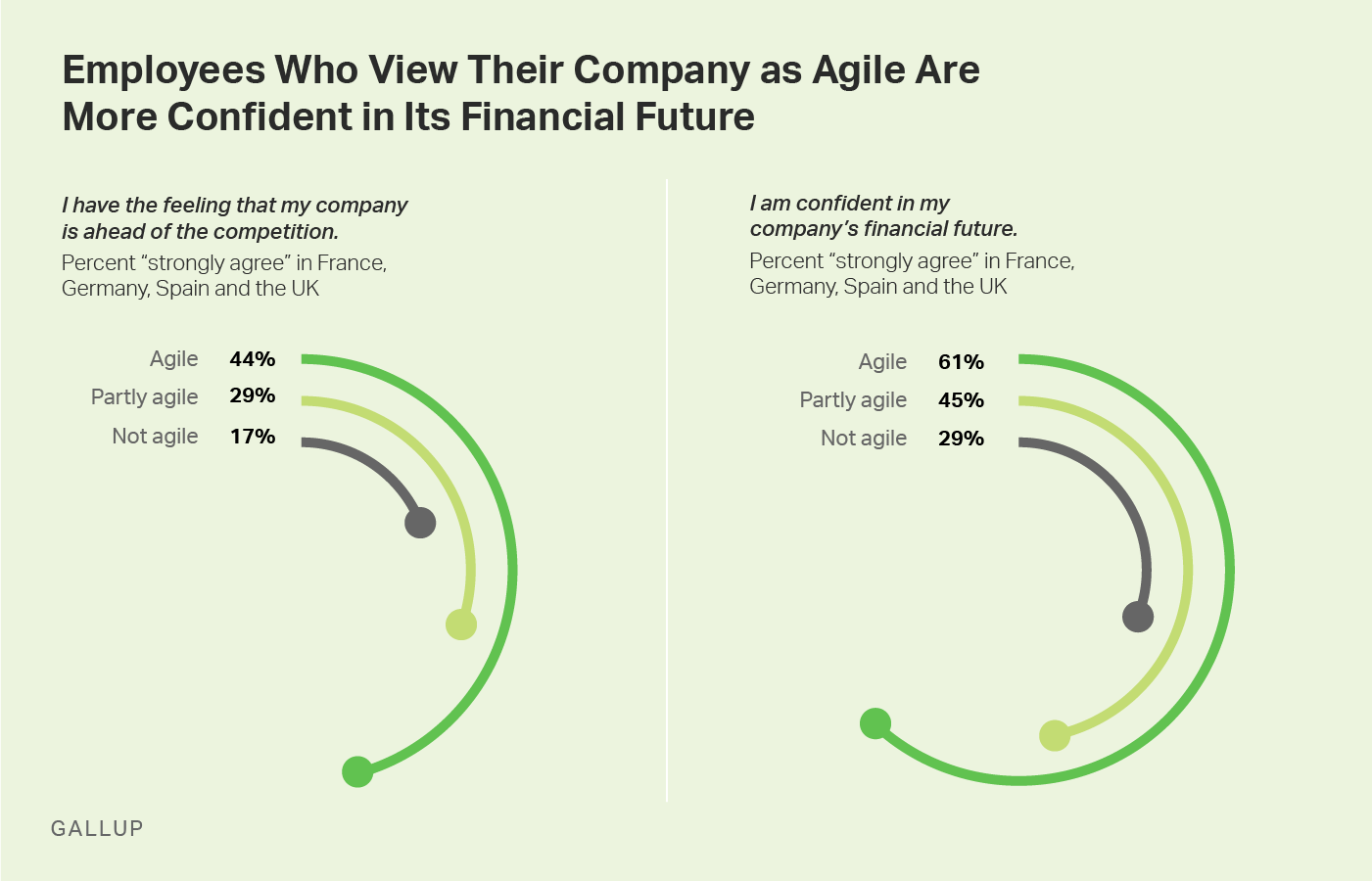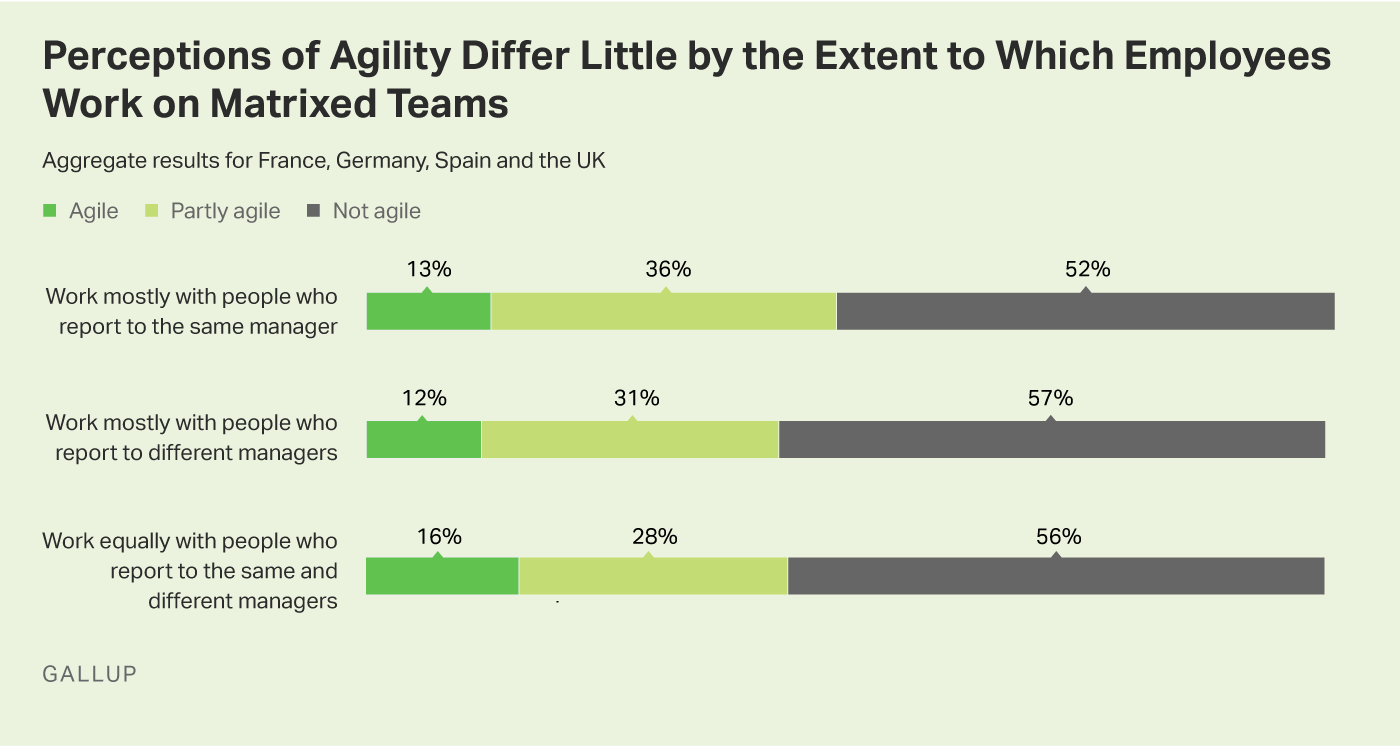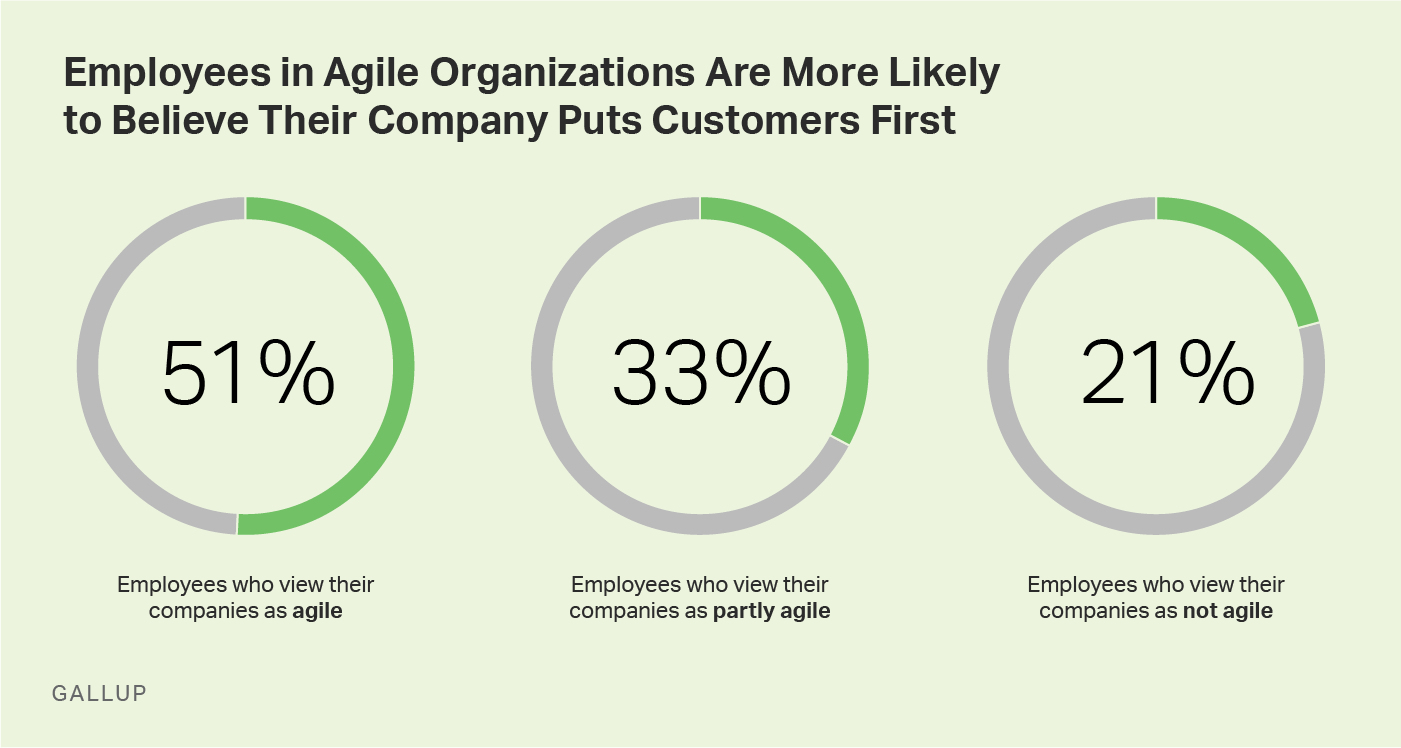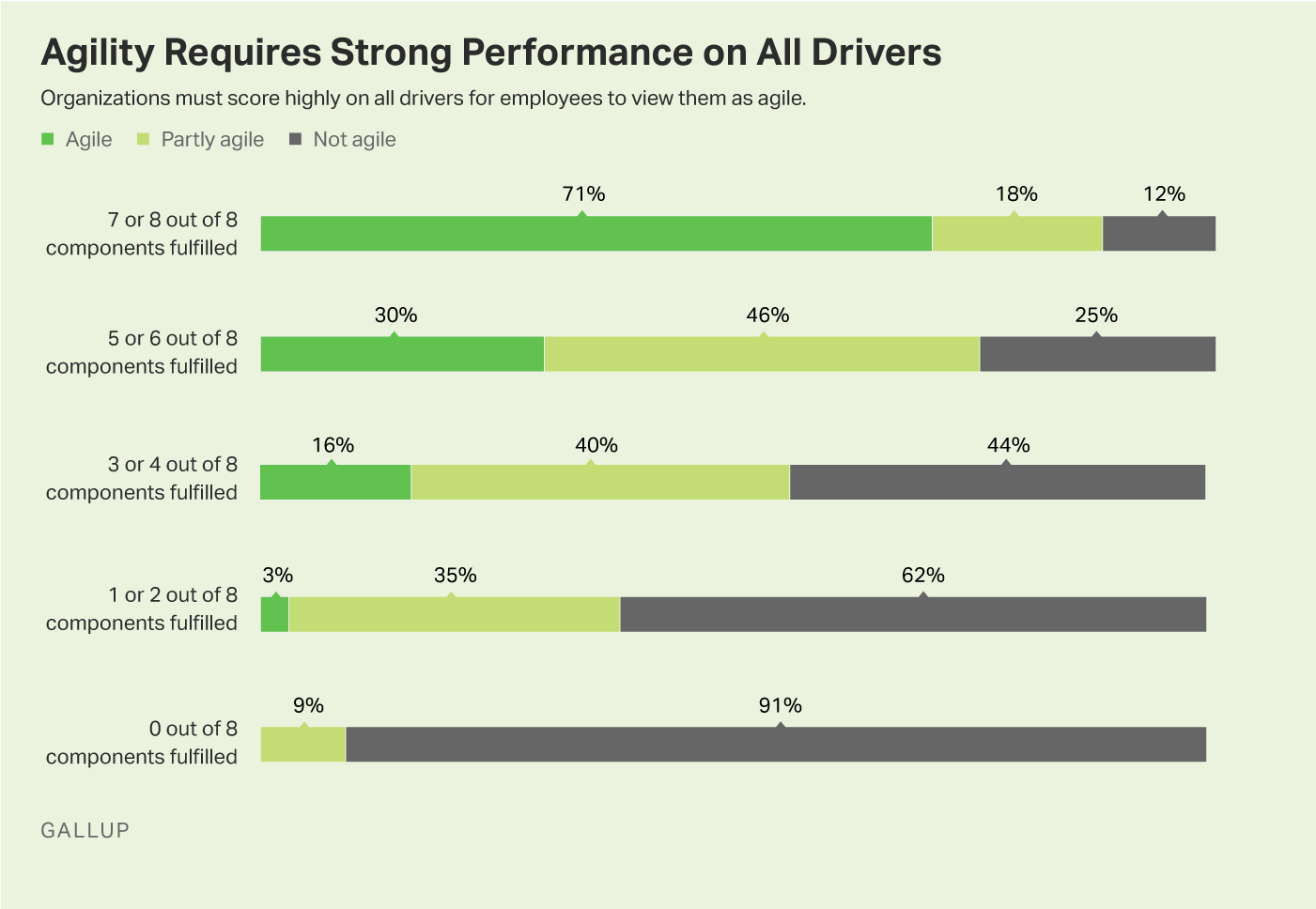Story Highlights
- Empower employees and simplify processes to work faster
- Create an environment where employees can try out new ideas
- Increase capacity through cross-team coordination
This article is from The Real Future of Work: The Agility Issue. Download the full digital publication today.
In operational terms, the concept of agility can be defined as employees' capacity to gather and disseminate information about changes in the environment, and respond to that information quickly and expediently.
From a strategic perspective, this combination of speed and data-driven innovation is increasingly important for many businesses to maintain a competitive advantage.
At Gallup, we measure agility by asking workers for their level of agreement with two general statements about their organizations:
- In my company, we have the right mindset to respond quickly to business needs.
- In my company, we have the right tools and processes to respond quickly to business needs.
Our recent study of employees in France, Germany, Spain and the UK provides a look at how they view their organizations' capacity for agility.

They point to considerable room for improvement in all four countries; in none of the four do more than about one in six employees (16%) fall into the "agile" category -- meaning they feel strongly that their companies have both the mindset and the right tools and processes to respond quickly to business needs.
The importance of a company's ability to respond quickly to business needs is reflected in a clear relationship between these perceptions and employees' optimism regarding their organization's overall performance.
Employees who view their company as "agile" are significantly more likely than those who do not to have confidence in its financial future, and to feel it is ahead of the competition.

Gallup's analysis points to specific conditions that support an organization's overall capacity for agility. Each of these primary drivers is a significant predictor of the general view among employees across the four countries studied that their organization is agile.
What's the path to agility?
1. Speed and efficiency: Pick up the pace.
Much of the talk about business agility centers on the speed with which employees can take action to solve problems.
Speed is associated with employee empowerment, decentralized decision-making and a focus on procedural simplicity. In modern workplaces, maximizing speed means readily adopting new productivity-enhancing technologies.
However, leaders must also proactively consider the potential for trade-offs between speed and quality.
Organizations should embed expectations for quality throughout their culture and consistently reinforce these expectations in performance development systems and routine conversations between managers and team members.
Employees should understand that being empowered to make more decisions that affect customers comes with the responsibility to uphold the organization's quality standards and that they are accountable for doing so.
Employees across the four countries are least likely to agree that they are satisfied with the speed of decision-making at work; about one in five "strongly agree."
For many, structural barriers may create frustration by impeding their performance.
Though employees are more likely to agree that those closest to the action are trusted to make decisions in their organizations, only one-third "strongly agree" with this statement.
| Speed and Efficiency | Freedom to Experiment | Communication and Collaboration | |||||||||||||||||||||||||||||||||||||||||||||||||||||||||||||||||||||||||||||||||||||||||||||||||
| Constantly make every job and process as simple as possible | Determine what risks are necessary and what failures are acceptable | Break down the silos between teams and departments | |||||||||||||||||||||||||||||||||||||||||||||||||||||||||||||||||||||||||||||||||||||||||||||||||
| Use technology to help employees get more done in less time | Help every person in the company feel they should contribute to innovation | Create opportunities for regular idea and knowledge sharing | |||||||||||||||||||||||||||||||||||||||||||||||||||||||||||||||||||||||||||||||||||||||||||||||||
| Remove unnecessary bureaucracy to decision-making | |||||||||||||||||||||||||||||||||||||||||||||||||||||||||||||||||||||||||||||||||||||||||||||||||||
| GALLUP 2018 | |||||||||||||||||||||||||||||||||||||||||||||||||||||||||||||||||||||||||||||||||||||||||||||||||||
2. Freedom to experiment: A new way of thinking.
Agile companies understand the importance of tapping employees' ingenuity to develop novel approaches to emerging business challenges.
It is critical that employees feel able to try new ideas without fear of failure, recognizing that learning from mistakes is an indispensable part of the creative process.
In our experience, however, many organizations do a better job of encouraging employees to share and discuss new ideas than they do of creating an environment where they are empowered to try them out.
Leaders must understand that for most large firms, experimentation can no longer be a prerogative of R&D teams only.
Agile companies understand the importance of tapping employees' ingenuity to develop novel approaches to emerging business challenges.
A new way of thinking about decision-making -- one that incorporates a constant flow of local-level customer data and continually tests prototype responses -- is becoming the new norm for agile organizations.
It's a profound mindset shift that forces decision-makers to act with an appreciation of what they don't know rather than being constrained by existing routines.
As with the increased focus on speed, leaders must be cognizant of the potential trade-offs associated with more routine experimentation.
For many organizations, it means becoming better at understanding and managing their risks.
Tools like risk management software can help embolden local managers by quantifying and communicating the risk associated with experimentation.
The key point is that in a continually evolving environment, the best strategy for minimizing risk over the long run is to be the quickest to try new things in response to data on changing conditions.
Gallup's recent study indicates that nearly one in four employees across France, Germany, Spain and the UK "strongly agree" that their company creates an environment where they can try, fail and learn from mistakes.
About one-third "strongly agree" that they are encouraged to come up with new and better ways of doing things.
Some employees may be wary of the consequences of failure, but many likely have mixed feelings about these items because they do not have regular opportunities to express their thoughts and opinions, and so are accustomed to taking the status quo for granted.
Such inertia is increasingly dangerous amid rapidly changing market conditions.
Leaders must learn to be wrong.
Hubris -- the excessive, unwarranted confidence that one is incapable of making the wrong decision -- has rarely been more dangerous than in today's business environment.
Effective leaders have the confidence to act amid uncertain conditions, but also the humility to recognize what they don't know and an openness to being wrong.
Establishing a culture of continual experimentation and data-driven decision-making means recognizing that no one will instinctively have all the answers, no matter how smart, experienced or senior they are.
For many leaders, this is a big ask. Psychologically, we value a sense of mastery, of control over our environment.
Agile businesses need leaders who resist that tendency and embrace the fact they often do not know the answer.
Such leaders may provide organizations with an overall vision and sense of direction, but they look to customers, front-line employees and the ever-evolving environment to provide answers for how to best implement that vision on a day-to-day basis.
3. Communication and Collaboration: Make working together easy.
Agile organizations mitigate potential trade-offs between speed and quality in part by routinely sharing relevant knowledge and expertise across teams, so that decentralizing decisions that address customer needs doesn't result in employees continually reinventing the wheel.
Increasing the capacity of employees throughout the organization to experiment is essential for agility -- but unless cross-team coordination and information-sharing is the norm, such experimentation can reduce efficiency and consistency.
Information Communication Technology tools have made geographic separation less of an impediment to collaboration and information flow, but organizations may still need to lower barriers that stem from systems (such as incentive structures or organizational silos) and mindsets (such as turf protection or internal politics).
From a systems perspective, leaders need to understand both formal and informal networks that connect employees to identify the roles, leaders and teams that play a critical part and support them accordingly.
Gallup's research on organizational mindsets that support collaboration has identified a few key elements most have in common, including fairness, trust, acceptance and a common mission.
In the strongest relationships, patterns also exhibit unselfishness and a lack of defensiveness, minimizing the potential for conflict and keeping team members focused on their collective goal.
Overall, a little over one-third of employees across the four countries surveyed "strongly agree" that they work in an environment where knowledge is openly shared.
Even fewer -- about one in four overall -- "strongly agree" that they are satisfied with the cooperation between their department and other departments in their company.
Matrix structures may make it harder for organizations to maintain clear expectations and lines of accountability.
Increased potential for collaboration is commonly cited as an advantage of highly matrixed organizations.
However, as a 2016 analysis by Gallup and McKinsey indicated, matrix structures may also make it harder for organizations to maintain clear expectations and lines of accountability.
Whether or not any given organizational structure translates to a heightened capacity to respond quickly to business needs likely depends on other underlying factors.
As employees in these four countries experience it, a company's agility has more to do with its workplace culture and the way it positions its managers than with any specific structural arrangement.

Matrixed does not equal agile.
Business leaders may be led to equate the potential for agility with a highly matrixed, team-based organizational structure.
However, Gallup's recent study of European employees finds little difference in their perceptions of agility based on the extent to which they work on matrixed teams.
Overall, across the four countries:
- 61% say they work mostly with people who report to the same manager that they do
- 9% say they work mostly with people who report to a different manager than they do
- 29% say they work equally with people who report to the same manager and different managers
Perceptions of their companies' agility differ little among the three groups.
Agile organizations are grounded in strong, customer-centric cultures.
For agile, decentralized structures and practices to work without eroding an organization's identity or reliability, they must be rooted in a foundation of strong, stable values.
One reason organizational culture has become such an important consideration for business leaders is that it helps teams and processes become more fluid and adaptable without losing sight of the organization's core purpose and sources of distinctiveness.
Customer-centricity is almost always a foundational cultural component for agile companies -- in fact, it is most often the reason businesses seek to become more agile in the first place.
The mindset required to support speed, adaptiveness and innovation is highly attuned to the needs and experiences of customers.
Explicitly placing data on what customers value at the center of all business processes helps break down organizational silos and changes the way employees think, communicate and act.
It's a priority that pervades the entire organization, whether employees interact primarily with customers external to the organization or internal "customers" in different roles or departments.
The connection between agility and customer-centricity is evident in the survey results from employees in France, Germany, Spain the UK.
Among employees who believe their company is able to respond quickly to business needs, a majority (51%) strongly agree that their coworkers always do what is right for customers.
That figure falls to 33% among employees in the "partly agile" category and about one-fifth (21%) among those who do not view their companies as agile.

Their greater focus on doing the right thing for customers may help explain why employees in agile companies are more confident in their organizations' competitiveness and financial performance.
Employees who strongly believe their companies are well-equipped to meet changing business needs are also far more likely to advocate for their organizations as employers; about two-thirds (64%) "strongly agree" that they would recommend their company as a place to work, versus just 19% of employees who do not view their companies as agile.
Perhaps most notably, employees' perceptions of their company's agility are strongly associated with their expectations for its future.
Overall, across the four counties studied, 20% of employees "strongly agree" that "The leadership of my company makes me enthusiastic about the future" -- but that figure rises to 48% among employees who regard their companies as "agile."

Ultimately, one of the most powerful advantages of agile companies is their ability to give employees a sense of optimism about the organization's capacity to survive -- and thrive -- amid disruptive marketplace conditions.
These results reflect the multidimensional nature of agility and indicate that businesses are unlikely to see much improvement until leaders and managers focus on all components simultaneously and model the day-to-day behaviors they require.
Foremost among these is the need to reflect on their leadership style, recognizing that a command-and-control culture does not encourage empowerment and that agile organizations have a different take on the role of managers.
This article is from The Real Future of Work: The Agility Issue. Download the full digital publication today.


